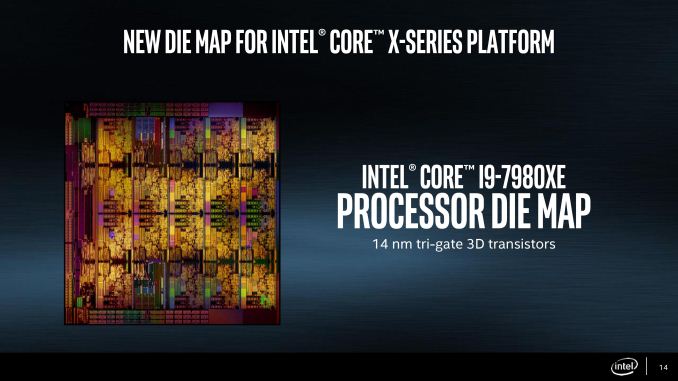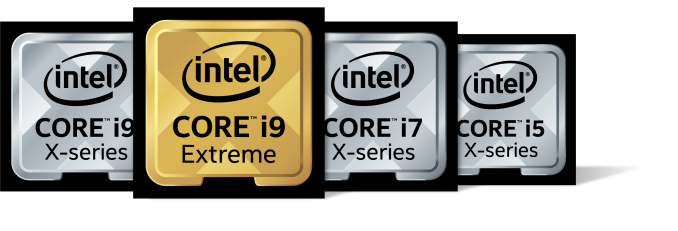The Intel Core i9-7980XE and Core i9-7960X CPU Review Part 1: Workstation
by Ian Cutress on September 25, 2017 3:01 AM ESTIntel Core i9-7980XE and Core i9-7960X Conclusion
In the 2000s, we had the frequency wars. Trying to pump all the MHz into a single core ended up mega-hurting one company in particular, until the push was made to multi-core and efficient systems. Now in the 2010s, we have the Core Wars. You need to have at least 16 cores to play, and be prepared to burn power like never before. With today’s launch, Intel has kicked their high-end desktop offerings up a notch, both in performance and power consumption.
Pun density aside, both Intel and AMD are pursuing a many-core strategy when it comes to the high-end desktop. Both manufacturers have the same story in their pockets: users need more multi-threaded performance, either for intense compute or for a heavy scoop of compute-based multi-tasking, to include streaming, encoding, rendering, and high-intensity minesweeper VR all at the same time. Due to having so many cores, single threaded performance while under load can be lower than usual, so both companies focus on throughput rather than responsiveness.
The Core i9-7980XE is Intel’s new top-of-the-line HEDT processor. Coming in at 18-cores and drawing 165W, this processor can reach 4.4 GHz at top turbo or 3.4 GHz on all-core turbo. At $1999, it becomes the most expensive (?) consumer focused processor on the market. It is priced at this level for two reasons: first such that it doesn’t cannibalize Intel’s enterprise sales which have a higher profit margin, but also due to Intel’s product stack it fills up several price points from $300 all the way to $2000 now, and with it being Intel’s best consumer processor, they are hoping that it will still sell like hot cakes.
Our performance numbers show that Intel’s best multi-core consumer processor is deserving of that title. In most of our multi-core tests, Intel has a clear lead over AMD: a combination of more cores and a higher single threaded performance compensates for any frequency difference. For anyone with hardcore compute, Intel gets you to the finishing line first in almost every scenario. AMD does win on a few benchmarks, which is something we saw when Johan tested the enterprise versions of Intel's and AMD's CPUs in his review, where he cited AMD’s FP unit as being the leading cause of the performance improvement.
There are going to be three cautionary flags to this tale based on our testing today, for anyone looking at Skylake-X, and they all start with the letter P: Power, Platform, and Price.
Power: In our testing, Intel’s cores can consume between 20W and 7.5W per core, which is a large range. When all cores are at load, as well as the mesh and DRAM controllers, the Core i9-7980XE draws over 190W, well above the TDP rating of 165W. This will cause concern for users that take the TDP value as rote for power consumption – and for any users thinking of overclocking it might also be worth investing in custom cooling loops. The processors from AMD consume ~177W at load, which for two cores less is about the same ballpark.
Platform: X299 motherboards are designed to handle Kaby Lake-X, Skylake-X LCC and Skylake-X HCC processors. Almost all the motherboards should be geared towards the high-end processors which makes platform compatibility a bit of a non-issue, however testing by others recommends some form of active cooling on the power delivery. When investing $1999 in a processor, especially if a user is considering overclocking, it is likely that a good motherboard is needed, and not just the bargain basement model. Some users will point to the competition, where AMD's processors offer enough lanes for three x16 GPUs and three PCIe 3.0 x4 storage devices from the processor at the same time, rather than reduced bandwidth for 3-way and requiring storage to go through the chipset.
Price: $1999 is a new record for consumer processors. Intel is charging this much because it can – this processor does take the absolute workstation performance crown. For high performance, that is usually enough – the sort of users that are interested in this level of performance are not overly interested in performance per dollar, especially if a software license is nearer $10k. However for everyone else, unless you can take advantage of TSX or AVX-512, the price is exorbitant, and all arrows point towards AMD instead. Half the price is hard to ignore.
Users looking at the new processors for workstation use should consider the three Ps. It’s not an easy task, and will highly depend on the user specific workflow. The recommendations ultimately come down to three suggestions:
- If a user needs the top best workstation processor without ECC, then get Skylake-X.
- If a user needs ECC or 512GB of DRAM, Xeon-W looks a better bet.
- If a user has a strict budget or wants another GPU for compute workloads, look at Threadripper.
For those weighing up the Core i9-7960X compared to the Core i9-7980XE, part of me wants to say ‘if you’re going for cores and prepared to spend this much, then go all the way’. If the main purpose is throughput, for the benchmarks that matter, the 7980XE is likely to provide benefit. For multi-taskers, the benefits are less clear, and it would be interesting to get the Core i9-7940X and Core i9-7920X in for testing.













152 Comments
View All Comments
mapesdhs - Monday, September 25, 2017 - link
Just curious mmrezaie, why do you say "unofficially"? ECC support is included on specs pages for X399 boards.frowertr - Tuesday, September 26, 2017 - link
Run Unbound on a Pi or other Linux VM and block all thise adverts at the DNS level for all the devices on your LAN. I havent seen a site add anywhere in years from my home.Notmyusualid - Thursday, September 28, 2017 - link
@frowertrInteresting - But that won't work for me - I'm a frequent traveller, and thus on different LANs all the time.
But what works for me, is PeerBlock, then iblocklist.com for the Ad-server & Malicious lists and others, add Microsoft and any other entity I don't want my packets broadcast to (my Antivirus alerts me when I need updates anyway - and thus I temporarily allow http through the firewall for that type of occasion).
realistz - Monday, September 25, 2017 - link
This is why the "core wars" won't be a good thing for consumers. Focus on better single thread perf instead quantity.sonichedgehog360@yahoo.com - Monday, September 25, 2017 - link
On the contrary, single-threaded performance is largely a dead end until we hit quantum computing due to instability inherent to extremely high clock speeds. The core wars is exactly what we need to incentivize developers to improve multi-core scaling and performance: it represents the future of computing.extide - Monday, September 25, 2017 - link
Some things just can't be split up into multiple threads -- it's not a developer skill level or laziness issue, it's just the way it is. Single threaded speed will always be important.PixyMisa - Monday, September 25, 2017 - link
Maybe, but it's still a dead end. It's not going to improve much, ever.HStewart - Monday, September 25, 2017 - link
As a developer for 30 years this is absolutely correct - especially with the user interface logic which includes graphics. Until technology is a truly able to multi-thread the display logic and display hardware - it very important to have single thread performance. I would think this is critically important for games since they deal a lot with screen. Intel has also done something very wise and I believe they realize this important - by allowing some cores to go faster than others. Multi-core is basically hardware assisted multi-threaded applications which is very dependent on application design - most of time threads are used for background tasks. Another critical error is database logic - unless the database core logic is designed to be multithread, you will need single point of entry and in some cases - they database must be on screen thread. Of course with advancement is possible hardware to handle threading and such, it might be possible to over come these limitations. But in NO WAY this is laziness of developer - keep in mind a lot of software has years of development and to completely rewrite the technology is a major and costly effort.lilmoe - Monday, September 25, 2017 - link
There are lots of instances where I'd need summation and other complex algorithm results from millions of records in certain tables. If I'm going the traditional sql route, it would take ages for the computation to return the desired values. I instead divide the load one multiple threads to get a smaller set in which I would perform some cleanup and final arithmetic. Lots of extra work? Yup. More ram per transaction total? Oh yea. Faster? Yes, dramatically faster.WPF was the first attempt by Microsoft to distribute UI load across multiple cores in addition to the gpu, it was so slow in its early days due to lots out inefficiencies and premature multi-core hardware. It's alot better now, but much more work than WinForms as you'd guess. UWP UI is also completely multithreaded.
Android is inching closer to completely have it's UI multithreaded and separate from the main worker thread. We're getting there.
Both you and sonich are correct, but it's also a fact that developers are taking their sweet time to get familiar with and/or use these technologies. Some don't want to that route simply because of technology bias and lock-in.
HStewart - Monday, September 25, 2017 - link
"Both you and sonich are correct, but it's also a fact that developers are taking their sweet time to get familiar with and/or use these technologies. Some don't want to that route simply because of technology bias and lock-in."That is not exactly what I was saying - it completely understandable to use threads to handle calculation - but I am saying that the designed of hardware with a single screen element makes it hard for true multi-threading. Often the critical sections must be lock - especially in a multi-processor system.
The best use of multi-threading and mult-cpu systems is actually in 3D rendering, this is where multiple threads can be use to distribute the load. In been a while since I work with Lightwave 3D and Vue, but in those days I would create a render farm - one of reason, I purchase a Dual Xeon 5160 ten years ago. But now a days processors like these processors here could do the work or 10 or normal machines on my farm ( Xeon was significantly more power then the P4's - pretty much could do the work of 4 or more P4's back then )